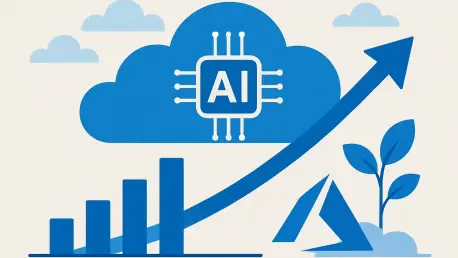The cloud computing industry is witnessing a transformative era, with Microsoft Azure, Amazon Web Services (AWS), and Google Cloud Platform (GCP) steering a colossal market valued at a quarter-trillion dollars each year, competing not just for dominance but reshaping the digital landscape through staggering investments, artificial intelligence (AI) innovations, and strategic maneuvers. Recent quarterly results reveal a fascinating interplay of growth, challenges, and ambition, as Azure rides an AI-driven wave, AWS grapples with capacity limitations, and Google Cloud quietly gains momentum. Beyond the raw numbers lies a deeper story of how supply chain bottlenecks, power shortages, and a massive capital expenditure (CapEx) race are defining the future of cloud services. This exploration delves into the forces propelling these giants, the hurdles they face, and the implications for a world increasingly reliant on cloud infrastructure. As AI becomes the heartbeat of technological advancement, understanding these dynamics offers critical insight into the next chapter of digital transformation.
AI: The New Frontier of Cloud Expansion
The rise of AI as a pivotal force in cloud computing cannot be overstated, with each major provider harnessing its potential to fuel unprecedented growth. Microsoft Azure stands at the forefront, capitalizing on its strategic partnership with OpenAI and the integration of ChatGPT to drive remarkable gains in AI inference workloads. This collaboration has not only boosted Azure’s reported growth but also reshaped how revenue is categorized, amplifying its market perception. While AI currently represents a modest portion of overall revenue across the industry—roughly 10% of the total—it’s evident that this segment is poised to become the cornerstone of future profitability. Azure’s ability to embed AI into its offerings signals a shift toward smarter, more adaptive cloud solutions that cater to a growing demand for intelligent applications. This momentum positions Azure as a leader in a space where innovation is as much about perception as it is about technology.
Meanwhile, AWS and Google Cloud are carving their own paths in the AI arena, each leveraging unique strengths to capture a slice of this transformative market. AWS taps into its expansive ecosystem, rolling out specialized tools like Trainium2 and Bedrock to support AI development and deployment. Though its growth in this area doesn’t match Azure’s headline figures, AWS benefits from a vast customer base that ensures steady adoption of its AI capabilities. Google Cloud, on the other hand, emphasizes its deep-rooted expertise in data and underlying technology, making it a compelling choice for AI-heavy workloads. Starting from a smaller base, its progress hints at untapped potential that could disrupt the competitive balance over time. As AI workloads evolve from experimental to essential, the ability of these providers to scale their offerings while addressing diverse enterprise needs will be a defining factor in their long-term success.
Capacity Bottlenecks: A Universal Hurdle
Across the board, capacity constraints are emerging as a significant barrier to the full realization of cloud growth potential, impacting even the most robust players. AWS has been candid about the issue, highlighting that its relatively modest growth rate isn’t a reflection of dwindling demand but rather a consequence of power shortages and component scarcity. These limitations are expected to persist for several quarters, creating a frustrating gap between market appetite and delivery capability. This scenario underscores a broader industry challenge: the infrastructure required to support surging cloud and AI demands is struggling to keep pace. For AWS, which remains the revenue leader, these constraints are particularly stark, as they obscure the true strength of customer interest and fuel criticism over perceived underperformance. Resolving these bottlenecks is not just a logistical necessity but a critical step in maintaining investor confidence.
Microsoft Azure and Google Cloud are not immune to these challenges, facing their own battles with supply tightness that temper otherwise explosive growth trajectories. Azure anticipates ongoing constraints through mid-2026, meaning its impressive growth figures—driven by AI adoption—still fall short of capturing the full extent of market demand. Similarly, Google Cloud is navigating capacity issues projected to extend into 2026, limiting its ability to fully capitalize on its upward momentum. This shared struggle creates an unusual market dynamic where reported growth rates are more indicative of supply-side limitations than actual consumer interest. For all three providers, the race to expand data center capacity and secure reliable power sources is becoming as competitive as the battle for market share, with significant implications for how their performances are judged in the near term.
The Staggering Scale of Capital Investment
The financial commitment to cloud infrastructure is reaching unprecedented levels, with the big three providers collectively on track to invest a staggering $240 billion in 2025 alone. This CapEx frenzy targets the expansion of data centers, power systems, and server capabilities essential for supporting both cloud services and AI workloads. AWS drives a significant portion of Amazon’s overall spending, while Google has raised its 2025 CapEx guidance to $85 billion, with expectations of further increases in the following year. Microsoft, too, is pouring over $30 billion into infrastructure for just a single quarter, reflecting a shared belief in the long-term payoff of these investments. However, with AI revenue currently hovering around $25 billion for 2025 across the industry, the disparity between expenditure and immediate returns raises questions about timing and profitability. This bold front-loading of costs illustrates a high-stakes gamble on future scalability in a market where demand shows no signs of slowing.
Such massive investments are not without risks, as the timeline for recouping these outlays remains uncertain amid evolving technological and regulatory landscapes. The focus on building out infrastructure to accommodate AI and cloud expansion highlights a strategic vision that prioritizes long-term dominance over short-term gains. For AWS, Google Cloud, and Azure, the ability to navigate power availability challenges, site permitting issues, and silicon supply constraints will be crucial in determining whether these investments translate into sustainable growth. Moreover, the competitive pressure to stay ahead means that any delay in infrastructure rollout could cede ground to rivals. As the industry watches this CapEx arms race unfold, the balance between aggressive spending and tangible outcomes will shape perceptions of each provider’s strategic acumen and financial health in the years ahead.
Diverging Growth Paths and Market Dynamics
Growth rates among the hyperscale cloud providers paint a varied picture, reflecting distinct strategies and market positions. Microsoft Azure’s remarkable 39% year-over-year growth stands out, fueled by AI inference workloads and strategic adjustments in revenue reporting. Though projected to ease slightly to 37% in the upcoming quarter, this surge has propelled Azure’s market share to 35.3%, marking a significant gain. This trajectory underscores how AI integration can redefine competitive standings, even as questions linger about the transparency of specific financial metrics. Azure’s momentum suggests a robust foundation for capturing a larger slice of the cloud market, particularly as enterprises increasingly prioritize AI-driven solutions. However, sustaining this pace will depend on overcoming supply constraints and maintaining innovation at scale.
In contrast, AWS, despite holding the top spot with a $124 billion annualized revenue run rate, posts a more restrained growth of 17.5%, leading to a dip in market share from 52.6% in 2024 to 48.6% in 2025. This slower pace has sparked scrutiny, though it’s largely attributed to capacity limitations rather than a lack of demand. Google Cloud, meanwhile, delivers a strong 32% overall growth, with its core infrastructure segments nearing 40%, maintaining a steady 10% market share from a smaller base. These disparities highlight a shifting landscape where AWS’s raw revenue dominance is challenged by Azure’s rapid ascent and Google Cloud’s consistent gains. As market dynamics evolve, the ability to translate growth into lasting competitive advantage will hinge on each provider’s capacity to address operational hurdles and capitalize on emerging opportunities.
Financial Performance and Profitability Trends
Profitability metrics offer a window into the financial health and operational efficiency of these cloud giants, revealing stark differences in their approaches. AWS continues to lead with a 32.9% operating margin, though this figure has slipped from 39% due to seasonal stock-based compensation and rising depreciation costs. This profitability reflects a mature, hardware-access business model that remains robust despite slower growth rates. The strength of AWS’s financial position provides a buffer against capacity challenges, allowing it to weather criticism over growth optics while maintaining leadership in raw revenue. However, the pressure to reinvest heavily in infrastructure could further strain margins if supply issues persist, making efficiency a critical focus for sustaining its edge.
Google Cloud demonstrates notable progress, with its operating margin climbing to 20.7% from a lower base of 11% a year ago, signaling disciplined execution and improving scale. This upward trend positions Google as a credible contender, balancing growth with financial stability. Microsoft’s cloud profitability, however, is less clear, as overall gross margins for its cloud division have declined to 68%, weighed down by the lower-margin nature of AI infrastructure within Azure. These contrasting financial outcomes highlight the diverse strategies at play—AWS prioritizes steady profitability, Google Cloud focuses on incremental improvement, and Azure grapples with the cost of rapid AI-driven expansion. As the industry moves forward, the interplay between investment, growth, and margins will be a key determinant of long-term viability for each provider.
Navigating the Future of Cloud Dominance
Reflecting on the recent performances of Microsoft Azure, AWS, and Google Cloud, it’s evident that the cloud computing sector stands at a critical juncture, driven by AI innovation yet tempered by significant operational constraints. Azure’s remarkable growth, propelled by strategic AI integration, marks a shift in market share dynamics, while AWS maintains its revenue supremacy despite capacity-driven slowdowns that frustrate stakeholders. Google Cloud, often overlooked, emerges as a formidable player with steady growth and profitability gains, proving its relevance in an AI-centric landscape. The collective $240 billion CapEx commitment highlights an era of bold investment, with outcomes hinging on resolving power and supply challenges.
Looking ahead, the path to sustained dominance requires actionable strategies to bridge the gap between current investments and future returns. Prioritizing scalable infrastructure solutions, securing reliable power sources, and advancing silicon technologies should remain top priorities for these hyperscalers. Additionally, fostering enterprise adoption of AI through accessible tools and clear ROI demonstrations can accelerate monetization. Monitoring risks such as data quality issues and regulatory hurdles will also be essential to avoid setbacks. As the industry anticipates a cloud up-cycle into 2026, the focus should shift toward converting pilot projects into production workloads, ensuring that the ambitious visions of today transform into the digital backbone of tomorrow.









